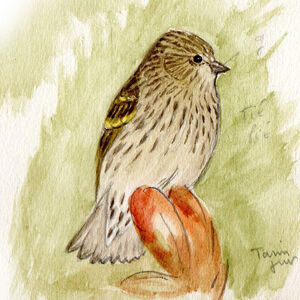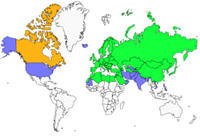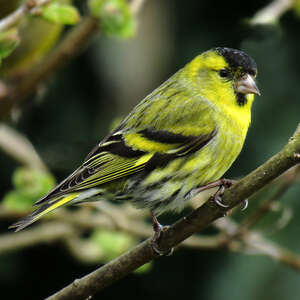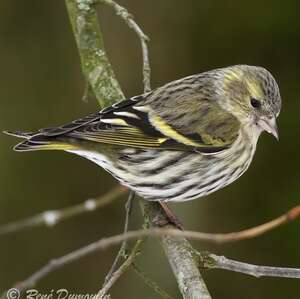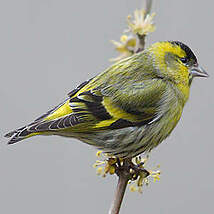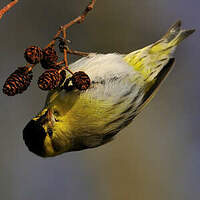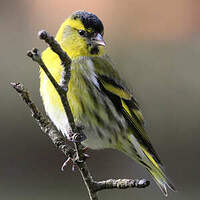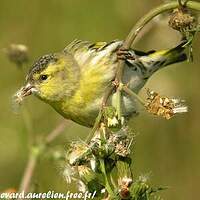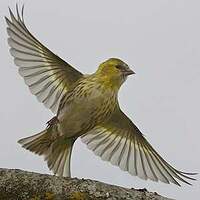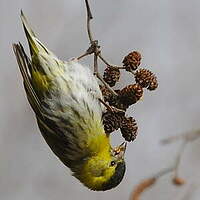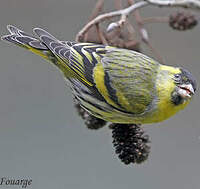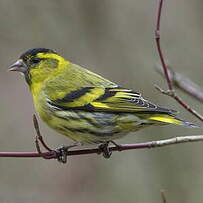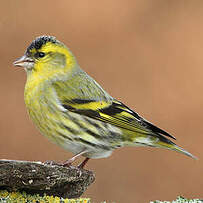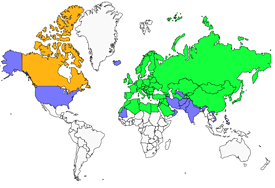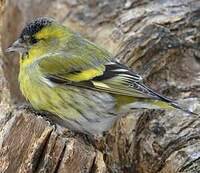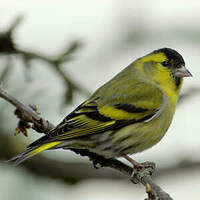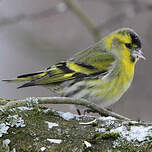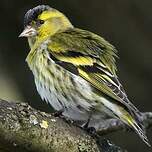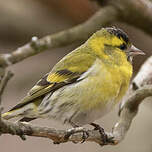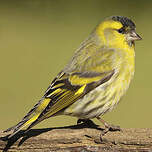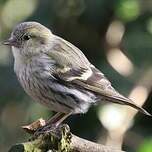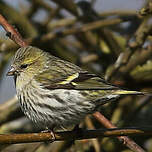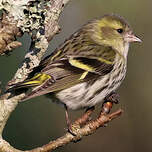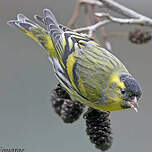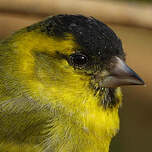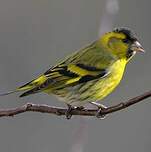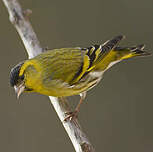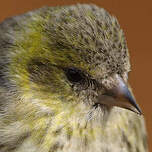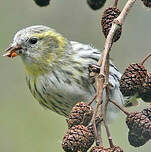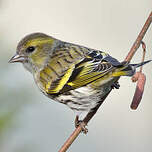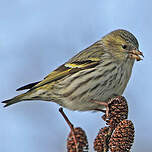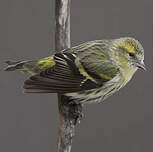Eurasian Siskin
Spinus spinus - Tarin des aulnes
Identification
The Eurasian Siskin is a small finch, smaller than a chaffinch. It is a bird of northern Europe and the southern mountains, and a common winter visitor to France. The adult male is recognized by the yellow which is present throughout its plumage, but not uniformly. The yellow is particularly bright on the sides of the head, the wing coverts, the rump and the tail. The underparts are also yellow, with varying degrees of black streaking depending on the individual. Some are heavily streaked on the flanks, while others have none at all, possibly related to their age. The mantle is mostly olive-coloured. When seen from the front, the cap, forehead, lores and chin are black, a secondary sexual characteristic. The beak is a horn-coloured, cone-shaped and pointed. The legs are reddish-brown. The adult female is substantially different. Firstly, she has no black on her head. Secondly, although having the same overall pattern of plumage, she is much less yellow than the male, being paler. The brightest yellow is on the rump. She is heavily streaked with black on the cap, mantle and all the underparts. The bare parts are the same as the male. The juvenile is even less colourful and more heavily streaked than the female. The yellow is present only on the wings (edging the primaries) and on the tail. The mantle is tawny with black streaking. The reddish tips to the median and larger coverts form two distinct wingbars. The beak is darker.
Subspecific information monotypic species
Foreign names
- Tarin des aulnes,
- Jilguero lúgano,
- lugre-comum,
- Erlenzeisig,
- csíz,
- Sijs,
- Lucherino,
- grönsiska,
- Grønnsisik,
- stehlík čížik,
- čížek lesní,
- Grønsisken,
- vihervarpunen,
- lluer eurasiàtic,
- Barrfinka,
- czyż (zwyczajny),
- ķivulis,
- čižek,
- Чиж,
- マヒワ,
- 黄雀,
- 黃雀,
Voice song and cries
The call is typical but difficult to transcribe. It consists of a tuui or tsuui or even tsiiu followed by a few low, dry and rushed notes tche tche tche. These last ones are particularly typical. They are somewhat reminiscent of their equivalent among Eurasian Siskins. The tuui alone is a contact call. The song is a typical finch babble, elaborate but unreadable, and when all the males of a flock perched in a tree start singing, it produces a rather melodious sound concert.
Habitat
I will only talk about the situation in the west of the Eurasian continent. The Eurasian Siskin is a frequent visitor of boreal coniferous forests as well as of high areas.
Behaviour character trait
Several elements draw attention to this species, firstly its distinctive little call, then the male's yellow plumage, its habit of gathering in compact groups and frequenting alder stands.
Three of these points were mentioned above. Let's just see here the strong gregariousness of the species which is manifested by the formation of groups in which the individuals are close to each other, whether in flight or perched. This is also what makes it recognisable when following a migration for example. Added to this is the flight of a small, well undulating finch, a bit bouncy. The groups vary from a few to a few tens of birds! On feeding sites, the Eurasian Siskin is often accompanied by other finches such as the Common Chaffinch, the Eurasian Bullfinch or the European Greenfinch. He is an acrobat who is not afraid to turn his back down to reach a few seeds at the end of a fruiting branch. The Eurasian Siskin is so discreet during the breeding period that an old German legend says that this bird hides in its nest a magic stone that makes it invisible.Flight
The flight of the Eurasian Siskin is a typical finch flight, undulate. It does not have the heaviness of that of a chaffinch and the small size of the bird makes its flight a bit bouncy. Its large wings are put to profit by migrants of the northern part of its area who have a lot of km to cover. The nuptial flight is a rapid flight with particular beats, like mechanical, wings held rigid.
Dietfeeding habits
The Eurasian Siskin is primarily a granivore. In Europe during winter, it is well-known for its strong dependence on alders and their numerous small seeds.
In summertime, its diet is much larger and includes the seeds of many species of trees and herbaceous plants, too many to list. Therefore, from this point of view, it behaves like other finches. In addition to the seeds, it also consumes buds, small fruits, and a portion of invertebrates such as insects and their larvae, spiders, small worms, etc. It may come to the feeder in winter, even for sunflower seeds.Reproduction nesting
The breeding season runs from late February to August. The Eurasian Siskin is monogamous and nests either alone or in small loose colonies in suitable forests.
The male performs a rapid flight with stiff wings and sings above the territory of the future nest. He also parades in front of the female, with his wings low, his black cap erect and the yellow feathers of his rump raised. The female builds her nest high in a conifer tree, often about twenty meters high, against the trunk or at the end of a branch. The male brings her some materials for the nest. It is made of twigs, vegetable fibers, rootlets, herbs, mosses and lichens and its bowl is lined with hair and feathers, carefully made and warm. The female lays 3 to 5 bluish white eggs with slight reddish spots and she incubates them alone for 12 to 13 days. Both adults feed the young in the nest during a period of about 14 days. Reproductive success is very dependent on the fruiting of the conifers in the nesting site. A good fruiting is a guarantee of reproductive success, and vice versa. The squirrel is an occasional predator of eggs and young.Geographic range
The breeding range of the Eurasian Siskin is split into two parts. In the west, a plains population occupies northern Europe and western Russia to approximately northern Mongolia and a southern population inhabits coniferous forests of southern European mountains. Most Fenno-Scandian and Russian siskins are migratory and winter in western and southern temperate Europe, Asia Minor, and a bit in the Maghreb. A Caucasian population is resident. In the east, a population is found in southeastern Russia, the far northeast of China and on Sakhalin Island. All of these birds are migratory and winter in Japan, the Korean peninsula, and eastern China.
Threats - protection
IUCN conservation status
concern
in the Wild
threatened
evaluated
This species is common and not threatened. It has been observed to be expanding in several European countries. If there are any problems, they could only be seen in the southern population centers due to the very hot and dry summers experienced in recent years.
Sources of information
- IOC World Bird List (v14.1), Gill, F and D Donsker (Eds). 2023.
- Finches and Sparrows, Peter Clement
- Monographie des Fringilles (vol 1), Michel Ottaviani
- Les passereaux d'Europe, tome 2, P. Géroudet, M. Cuisin
- Avibase, Lepage Denis
- Birds of the World, The Cornell Lab of Ornithology
- xeno-canto, Sharing bird sounds from around the world,
Other sources of interest
 Specification sheet created on
16/07/2023 by Jean François
Specification sheet created on
16/07/2023 by Jean FrançoisTranslation by AI Oiseaux.net
published: 24-11-2020 - Updated: 24-11-2020
© 1996-2024 Oiseaux.net
- Accipitriformes
- Aegotheliformes
- Anseriformes
- Apodiformes
- Apterygiformes
- Bucerotiformes
- Caprimulgiformes
- Cariamiformes
- Casuariiformes
- Charadriiformes
- Ciconiiformes
- Coliiformes
- Columbiformes
- Coraciiformes
- Cuculiformes
- Eurypygiformes
- Falconiformes
- Galliformes
- Gaviiformes
- Gruiformes
- Leptosomiformes
- Mesitornithiformes
- Musophagiformes
- Nyctibiiformes
- Opisthocomiformes
- Otidiformes
- Passeriformes
- Pelecaniformes
- Phaethontiformes
- Phoenicopteriformes
- Piciformes
- Podargiformes
- Podicipediformes
- Procellariiformes
- Psittaciformes
- Pterocliformes
- Rheiformes
- Sphenisciformes
- Steatornithiformes
- Strigiformes
- Struthioniformes
- Suliformes
- Tinamiformes
- Trogoniformes

